We made the most detailed maps possible of Pennsylvania’s 2022 midterm election
The Inquirer collected the election results from all of more than 9,000 precincts across the state. Here’s what they show.
Who prevailed in Pennsylvania’s 2022 statewide elections has long been clear: John Fetterman won the U.S. Senate race, and Josh Shapiro won the governorship.
But now you can see exactly how each candidate did in your neighborhood.
The Inquirer compiled data from each of Pennsylvania’s counties at the most granular level possible: the voting precinct. Often covering just a few city blocks, precincts are the tiny geographic units at which Pennsylvania ballots are tabulated.
And the election didn’t play out the same way across the state.
We’ve previously explored how Fetterman outperformed Joe Biden across most, but not all, of the state; how Southwestern Pennsylvania powered his win; and how not all groups turned out in equal numbers.
After calling and emailing county elections officials, writing code to turn images of election results into usable data — and sometimes entering data by hand — we’ve brought this closely divided state’s complicated politics into even sharper view.
Let’s look at some maps.
How Pennsylvania precincts voted
Each precinct is colored by the percentage of its vote that went to Democrats and Republicans. Democrats performed best in cities and dense suburbs, while Republicans were strongest in exurbs and rural areas.

U.S. Senate
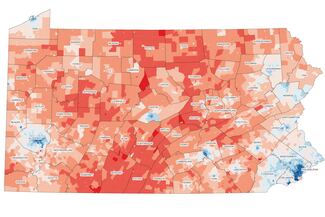
Governor
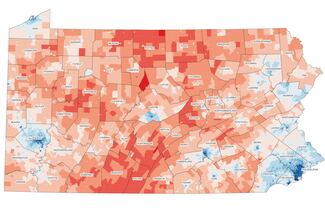
Pennsylvania, like the rest of the country, has become more and more polarized between blue cities and red rural areas; Winning such a closely divided state means maximizing turnout in core areas while persuading as many voters as possible in battleground suburban and exurban areas.
This year’s Senate and governor’s races demonstrated that once again. Across the state, geographically concentrated dark-blue cities were surrounded by progressively lighter-blue suburbs before giving way to light-red exurbs. Surrounding them was a vast sea of red, where Pennsylvania’s heavily Republican-leaning rural population lives.
Southeastern Pa. (U.S. Senate)
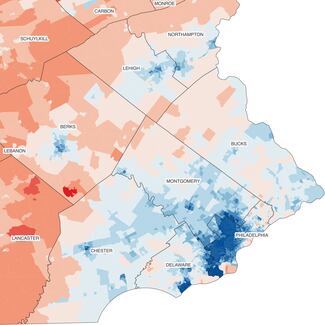
Southeastern Pa. (Governor)
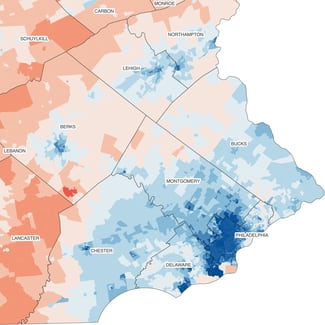
Western Pa. (U.S. Senate)
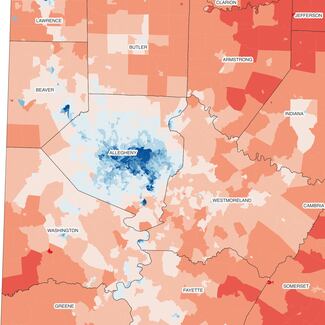
Western Pa. (Governor)

Northeastern Pa. (U.S. Senate)
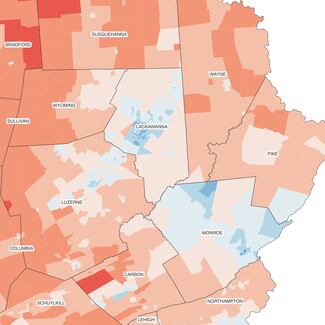
Northeastern Pa. (Governor)
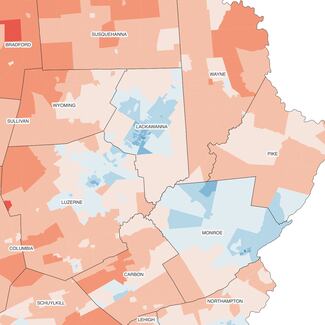
How Pennsylvania’s vote was distributed
Each dot represents one voter in a precinct, colored according to how they voted for Senate. Although rural areas are very Republican, they are sparsely populated, with Republican voters more densely concentrated in suburbs and exurbs; Democrats cluster in and around cities.
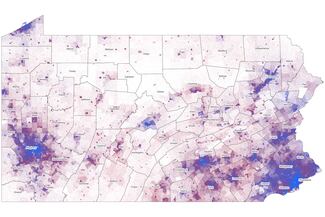
Staring at a map of red and blue precincts can be misleading: Land doesn’t vote. And Democrats and Republicans typically live in very different places.
Looking at maps of where voters live reveals how important the swing suburbs and exurbs actually are: Pennsylvania’s vast rural precincts are heavily Republican and sparsely populated, but roughly as influential taken together as cities.
But the maps also show that cities aren’t monoliths either. Hundreds of thousands of Republicans live in cities, and their votes add up, too.
Philadelphia, the state’s largest city and biggest source of Democratic votes, contains a significant number of Republicans — and not just in the traditional GOP enclaves of white working-class neighborhoods in South Philly and the Northeast. Although Democrats are the largest group in most places, Republican voters live throughout the city and its suburbs, helping pad the margins of Republican candidates who wouldn’t be able to compete on the strength of “red” precincts alone.
Southeastern Pa.
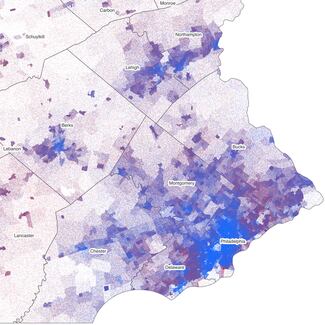
Western Pa.

Northeastern Pa.
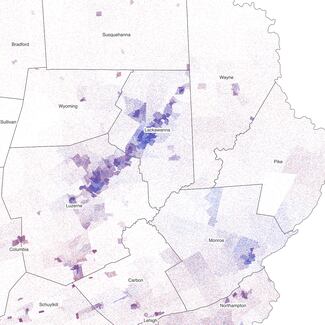
How Pa.'s 2022 vote compares with 2020
Each arrow represents the change in the two-party vote share: The longer the arrow, the bigger the shift. Most of the state – except swaths of Southeastern Pennsylvania – voted for Fetterman by larger margins than for Biden; nearly the whole state gave a much larger vote share to Shapiro than to Biden.

U.S. Senate 2022
Governor 2022
No “red wave” materialized in Pennsylvania this year, defying historical trends that typically favor the party out of the presidency. That stood in sharp contrast to states like New York and Florida, both of which did swing right. It’s more in line with other battlegrounds such as Michigan, where Democrats performed well.
Strikingly, precincts all across the state swung to the left this year compared with Biden’s narrow win in 2020.
Read more
Fetterman improved on Biden’s margins virtually everywhere — with the notable exception of the Philly suburbs, where scores of precincts put up larger margins for Republican Senate nominee Mehmet Oz than they had for Donald Trump. That suburban Republican support was offset by large swings toward Fetterman in Southwestern Pennsylvania, where working-class precincts in counties surrounding Pittsburgh gave him a home-field advantage (Fetterman was a longtime mayor of nearby Braddock).
Shapiro performed even better: Few precincts favored Republican gubernatorial nominee Doug Mastriano by higher margins than they did Trump.
How turnout fell from 2020
The darker the shade of orange, the sharper the drop in votes cast. Trends were uneven, but turnout notably dropped sharply in Philadelphia and some adjacent areas.

U.S. Senate 2022

Fetterman and Shapiro outdid Biden only in relative terms. Biden netted far more actual votes — many more voters participate in presidential elections than midterms.
Read more
The number of votes cast was down 22% statewide from 2020 to 2022. Urban precincts saw some of the sharpest turnout declines, though there wasn’t much of a geographic pattern to the turnout change beyond that.
Suburban and rural areas, Democratic-leaning and Republican-leaning precincts alike, all posted vote totals well below those of 2020.
Southeastern Pa.
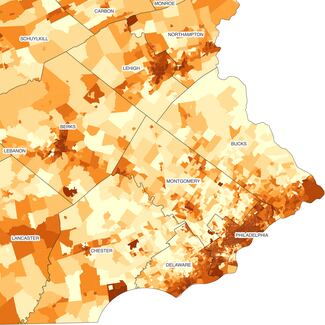
Western Pa.
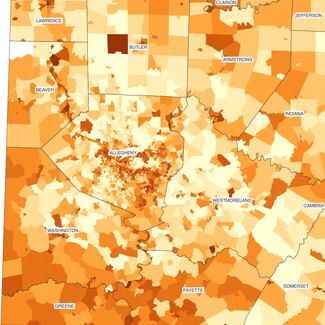
Northeastern Pa.
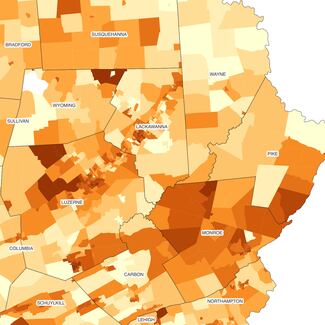
How the Senate and governor races differ
The darker the purple, the more Oz outran Mastriano (or the more Shapiro outran Fetterman). In only a few precincts, colored orange, did Mastriano outperform Oz outright.

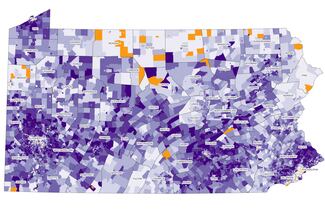
Southeastern Pa.

Western Pa.

Northeastern Pa.

While Shapiro outran Fetterman across the state, he didn’t do so by equal amounts everywhere.
Once again, it’s suburban precincts that stand out. They distinguished themselves by a particular willingness to split their tickets: Suburbs had the highest share of voters choosing both Shapiro for governor but also Oz for Senate.
Rural and urban precincts, by contrast, were more similar than different on this measure: While they voted for candidates of different parties, they tended to stick with that party for both offices.
About the data
The data in these maps are drawn from three sources: the Census Bureau for maps of precinct boundaries, the Pennsylvania Department of State for 2020 presidential election results, and the various boards of elections for each of Pennsylvania’s 67 counties for 2022 results.
The shading of maps by margin of victory reflects only the Democratic and Republican two-party vote shares, excluding votes for other parties or write-ins.
Some precincts in a handful of counties did not report data. In most cases, that’s because the population size of these precincts was very small or because the municipality spanned county lines and data was reported only from the county with the more populous portion of the municipality.
In some cases, data from two different precincts were combined by a county. In cases where both precincts were captured in the Census maps, the data for the combined precincts were separated proportionally according to the population of each precinct.
Staff Contributors
- Data collection and processing: Aseem Shukla, Kasturi Pananjady, Jared Mitovich, and Jonathan Lai
- Reporting and writing: Aseem Shukla
- Mapping: Aseem Shukla
- Editing: Jonathan Lai and Dan Hirschhorn
- Digital editing: Patricia Madej